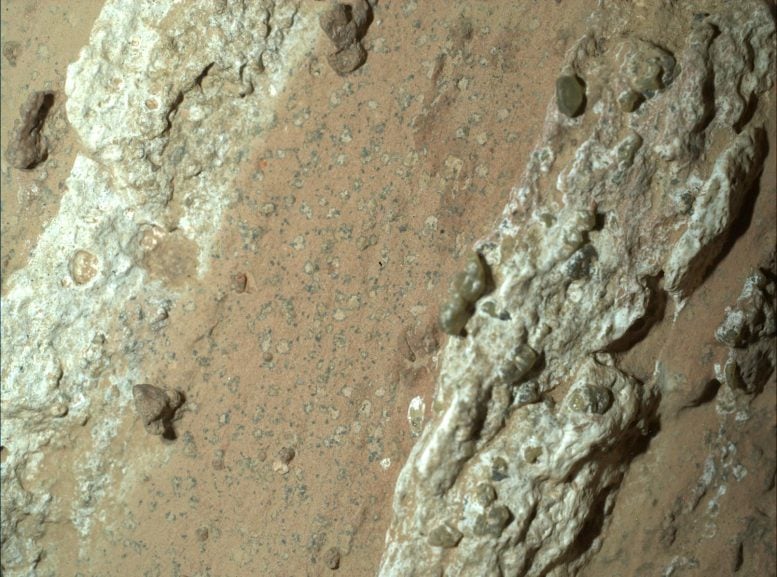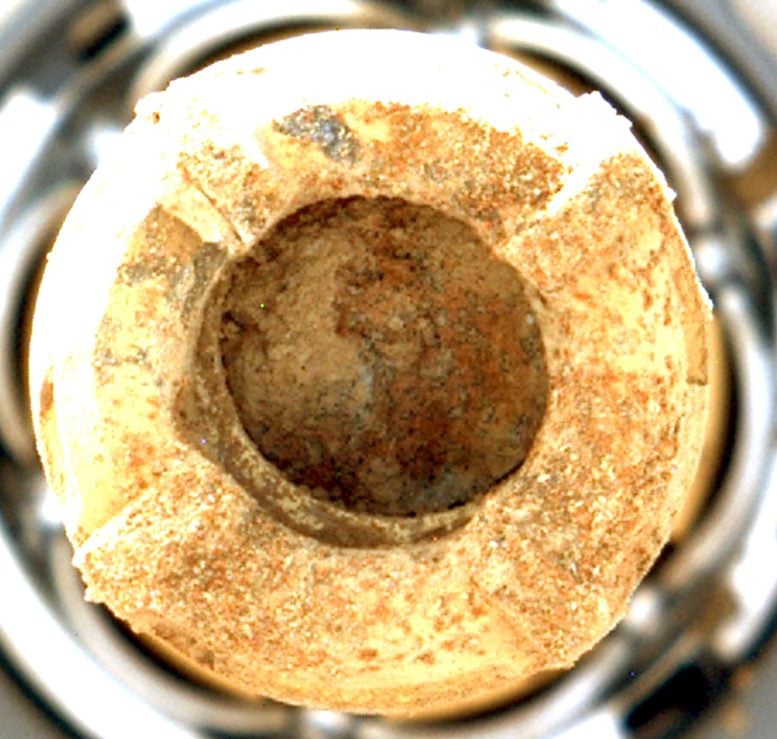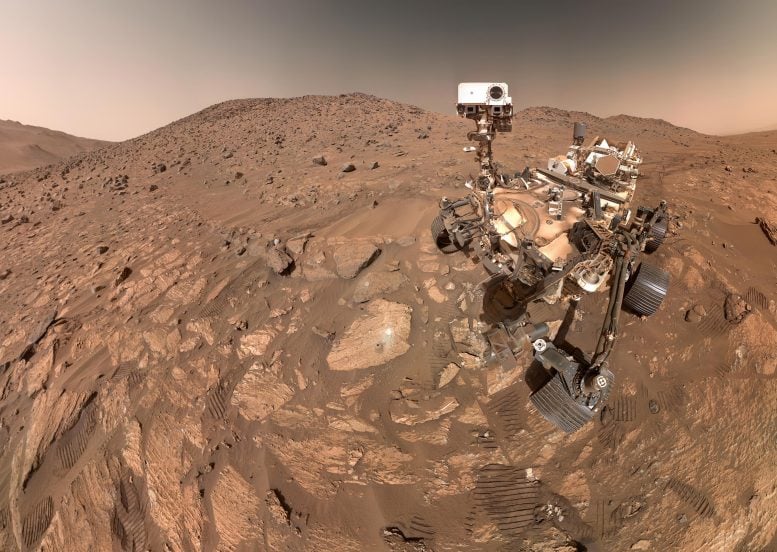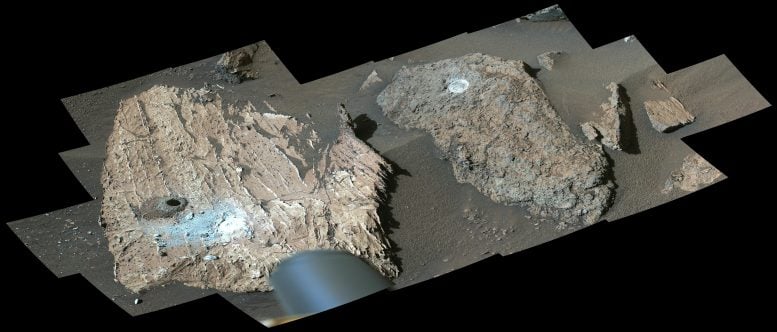
NASAThe Perseverance rover has discovered a fascinating stone on Marscalled Cheyava Falls, shows possible signs of ancient life due to its unique chemical signature and structural features.
This finding, supported by the presence of organic compounds and distinct color patterns suggesting microbial activity, prompts ongoing research to determine the habitability of Mars.
Discovering Cheyava Falls Rock
A vein-riddled rock catches the attention of the science team on NASA’s Perseverance rover. The arrow-shaped rock, which the team named “Cheyava Falls,” has intriguing features that may raise questions about whether microscopic life existed on Mars in the distant past.

Analysis by instruments on board the rover shows that the rock has properties that meet the definition of a possible indicator of early life. The rock has chemical signatures and structures that could have been formed by life billions of years ago, when the area explored by the rover contained flowing water. Other explanations for the observed features are being considered by the science team, and further research will be needed to determine whether early life is a valid explanation.

Sampling and exploration strategy
The stone – the rover’s 22nd rock core sample — were collected on July 21 as the rover explored the northern edge of the Neretva Vallis, a 400-meter-wide ancient river valley formed long ago by water flowing into the Jezero crater.
“We planned the route for Perseverance to take us to areas where we might find interesting scientific samples,” said Nicola Fox, deputy director of the Science Mission Directorate at NASA Headquarters in Washington. “This trip through the riverbed of the Neretva Valley was worthwhile because we found something we’ve never seen before and that gives our scientists a lot to study.”

Multiple scans of the Cheyava Falls by the rover’s SHERLOC (Scanning Habitable Environments with Raman & Luminescence for Organics & Chemicals) instrument suggest that they contain organic compounds. While such carbon-based molecules are considered the building blocks of life, they can also be formed by non-biological processes.
“Cheyava Falls is the most enigmatic, complex, and potentially significant rock studied by Perseverance to date,” said Ken Farley, Perseverance project scientist at Caltech in Pasadena. “On the one hand, we discovered organic material for the first time, distinctive colorful patches that indicate chemical reactions that microbial life could use as an energy source, and clear evidence that water — necessary for life — once flowed through the rock. On the other hand, we have not been able to determine exactly how the rock formed and to what extent nearby rocks might have heated Cheyava Falls and contributed to these features.”
Other details about the rock, which measures 1 x 0.6 meters and was named after a waterfall in the Grand Canyon, also fascinated the team.

How stones get their spots
In its search for signs of ancient microbial life, the Perseverance mission focused on rocks that might have been formed or altered long ago by the presence of water, so the team focused on Cheyava Falls.
“SHERLOC was built for such key observations – the search for organic matter, as it is an essential part of the search for past life,” said SHERLOC principal investigator Kevin Hand of NASA’s Jet Propulsion Laboratory in Southern California, which leads the mission.
Large white veins of calcium sulfate run the entire length of the rock. Between these veins are bands of material whose reddish color indicates the presence of hematite, one of the minerals that gives Mars its characteristic rusty hue.

Unusual mineral patterns and their meaning
When Perseverance took a closer look at these red regions, it discovered dozens of irregularly shaped, millimeter-sized cream-colored spots, all surrounded by black material, similar to leopard spots. Perseverance’s PIXL (Planetary Instrument for X-ray Lithochemistry) instrument has determined that these black halos contain both iron and phosphate.
“These spots are a big surprise,” said David Flannery, an astrobiologist and member of the Perseverance science team at Queensland University of Technology in Australia. “On Earth, such rock formations are often associated with fossilized traces of microbes living underground.”

Spots of this type on sedimentary rocks can form when chemical reactions involving hematite turn the rock from red to white. These reactions can also release iron and phosphate, possibly leading to the formation of the black halos. Reactions of this type can be a source of energy for microbes, which explains the connection between such features and microbes in a terrestrial environment.
In one scenario considered by the Perseverance team of scientists, Cheyava Falls was first deposited as mud containing organic compounds that eventually cemented into rock. Later, a second flow of fluid penetrated cracks in the rock, allowing mineral deposits to form, creating the large white veins of calcium sulfate seen today that gave rise to the spots.
NASA’s Perseverance rover has made very compelling observations in a Martian rock that, if examined further, could prove that there was life on Mars in the distant past – but how can we tell from a rock and what do we need to do to confirm it? Morgan Cable, a scientist on the Perseverance team, takes a closer look. Image credit: NASA/JPL-Caltech
Another piece of the puzzle
Although both the organic matter and the leopard spots are of great interest, they are not the only aspects of the Cheyava Falls rocks that puzzle the team of scientists. They were surprised to discover that these veins are filled with millimeter-sized crystals of olivine, a mineral that forms from magma. The olivine may be related to rocks that formed further up the edge of the river valley and may have been formed by the crystallization of magma.
If so, the team must answer another question: Could olivine and sulfate have penetrated the rock at unbearably high temperatures and triggered an abiotic chemical reaction that led to the leopard spots?

“We’ve shot this rock with lasers and X-rays and photographed it from literally every angle imaginable, day and night,” Farley said. “Scientifically, Perseverance has nothing more to offer. To fully understand what really happened in this Martian river valley at Jezero Crater billions of years ago, we would need to bring the sample from Cheyava Falls back to Earth so it can be studied with the powerful instruments available in laboratories.”
Mission overview
NASA’s Perseverance rover, a cornerstone of the Mars 2020 mission, is tasked with conducting groundbreaking exploration focused primarily on astrobiology. Its primary mission is to search for signs of ancient microbial life and pave the way for future human missions by thoroughly characterizing Mars’ geology and climate. This sophisticated rover is the first of its kind designed not only to study Mars’ surface features, but also to collect and store rock and regolith samples. These samples will be returned to Earth as part of NASA’s Mars Sample Return Program in collaboration with the European Space Agency (ESA) for a comprehensive analysis.
This ambitious mission is an integral part of NASA’s broader lunar-Mars exploration strategy, which includes the Artemis missions to the Moon. These lunar missions serve as a preparatory step toward the ultimate goal of human exploration of Mars. The Perseverance rover itself will be controlled by NASA’s Jet Propulsion Laboratory, operated by Caltech, which will provide world-class monitoring and execution of its operations on the Martian surface. This strategic approach aims not only to unlock the mysteries of life and Martian history, but also to lay the groundwork for the next major step in human space exploration.



